Amid the Gingerbread, Some Powerful Improvements
Microsoft Word has, for more than a decade, been the world's primary word processor program. Word 2007 was revolutionary, but Word 2010 is evolutionary. The most significant change for power users is the ability to modify the Ribbon, but security features and the ability to recover a document you neglected to save are also welcome improvements. Word's developers continue to push the application down the path of being a publishing program and I'm not as happy about that.
First, a Warning: Challenges in an Office Divided
Many of Word 2010's new features don't translate well if someone who is using Word 2007 or Word 2003 needs to open the document. In 2007, some of Word 2010's advanced features will be invisible, some will be converted, and some will be lost. In 2003, it's even worse: Most advanced features will be lost.
 What this means is that a 2010 document edited in one of the earlier versions of Word will return to the originator with dynamic features that have been converted to static features or with features missing. The Options panel allows you to turn off most of Word 2010's new features, but if you've paid for the upgrade, why would you do that?
What this means is that a 2010 document edited in one of the earlier versions of Word will return to the originator with dynamic features that have been converted to static features or with features missing. The Options panel allows you to turn off most of Word 2010's new features, but if you've paid for the upgrade, why would you do that?
You won't lose text, but if the originator has made heavy use of Word 2010's new capabilities, that person is going to be sorely disappointed when the document comes back with many of those features ripped out. In an office with mixed versions of Word, one option is to run Word in compatibility mode, but then you can't use the new features. A better option is upgrading all users to the current version, but that's expensive.
The Advanced Options Pane (the long image over at the right) shows some of the settings you can change in Word. If you click it so that it expands, you won't be able to see the entire image. But you'll see enough to realize that it's overwhelming.
Word Takes Security Seriously
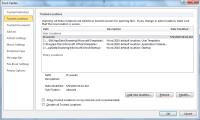 If you attempt to open a Word document that you've received as an e-mail attachment or otherwise obtained from the Internet, or if the document you're attempting to open contains macros, Word will warn you about the potential for unsafe content. This isn't new; the feature was added in the 2007 version. Unlike with Word 2007, though, in Word 2010 you are able to read the document even without opening it. All macros are disabled. This way you can review the document to confirm that it's safe, not just have to guess that it's safe.
If you attempt to open a Word document that you've received as an e-mail attachment or otherwise obtained from the Internet, or if the document you're attempting to open contains macros, Word will warn you about the potential for unsafe content. This isn't new; the feature was added in the 2007 version. Unlike with Word 2007, though, in Word 2010 you are able to read the document even without opening it. All macros are disabled. This way you can review the document to confirm that it's safe, not just have to guess that it's safe.
This security feature can be disabled, but I can't recommend doing that. Disabling the security feature could save a few seconds each week, but at considerable risk.
Access users will recognize the Trust Center and the Trusted Locations Panel. It is here that you can tell Word which locations you consider to be safe. In other words, documents stored in these specific locations will always be considered safe and will open without a warning.
Wear a Ribbon in Your Hair
The Ribbon, which was new in Word 2007, continues in 2010, but now you can modify the Ribbon's contents. Microsoft thought that the Quick-Access component of the 2007 applications would be sufficient, but power users quickly told them that they were wrong.
As a result, the Ribbon now is something that can be configured by the user. You can add any of the hundreds of commands that are not on any Ribbon component, or your own macros, to new tabs on the Ribbon.
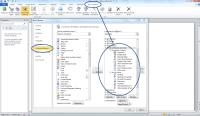 To illustrate the process, I created a new tab called My Commands (Clever, eh!) on the Ribbon and set up 2 new groups within the tab: Document and Text. Then I added several commands to each of the groups. These aren't necessarily commands that I would use, but they illustrate how easy it is to modify the user interface.
To illustrate the process, I created a new tab called My Commands (Clever, eh!) on the Ribbon and set up 2 new groups within the tab: Document and Text. Then I added several commands to each of the groups. These aren't necessarily commands that I would use, but they illustrate how easy it is to modify the user interface.
Follow Me Backstage
What used to be the File menu or, in 2007, the screen that opened if you clicked the Orb, is now "Backstage". This is an area that power users will instinctively gravitate to.
 The ability to pin documents to the File menu has been enhanced to allow pinning directories or other file locations. While this might seem to be a minor feature, it makes accessing obscure locations fast and easy.
The ability to pin documents to the File menu has been enhanced to allow pinning directories or other file locations. While this might seem to be a minor feature, it makes accessing obscure locations fast and easy.
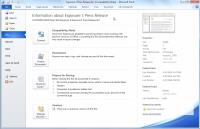 This is also where you can view information about the document you're currently editing and set properties that control who has access to the document and what they can do with it.
This is also where you can view information about the document you're currently editing and set properties that control who has access to the document and what they can do with it.
Why You Should Be Stylish
Styles are not new to Word, but some people still don't use them. Instead of creating a "Subhead" style, for example, they individually hand-code each and every subhead in the document to be "Frutiger Bold, 14 points, with 6 points of space before and 3 points of space after". What happens when you decide that the subheads should really be "Futura Ultra Bold, 16 points, with 12 points of space before and 3 points after"? If you have a document that has 751 subheads, you'll spend the next day or two making 751 changes.
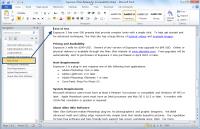 If, instead, you have used styles, you'll spend about 30 seconds making one change that will apply to 751 paragraphs.
If, instead, you have used styles, you'll spend about 30 seconds making one change that will apply to 751 paragraphs.
Starting with Office 2010, more reasons exist to use styles. The Navigation Window provides an overview of the document and a quick way to move from where you are in the document to where you need to be.
But only if you have used styles.
You Can Count on Word
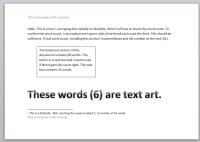 Word 2003 and Word 2007 didn't always count all the words in a document, but Word 2010 offers the option of counting all the text in the base document, in text boxes, and in footnotes and end notes. I ran a small test to confirm this claim.
Word 2003 and Word 2007 didn't always count all the words in a document, but Word 2010 offers the option of counting all the text in the base document, in text boxes, and in footnotes and end notes. I ran a small test to confirm this claim.
- Body text only
58 words (Word counts 58.) - Body text and text box (box contains 34 words)
92 words (Word counts 92.) - Body text, text box, and footnote (footnote contains 14 words)
106 words (Word counts 106.) - Body text, text box, footnote, header, and footer (header/footer each contain 7 words, 14 total)
120 words (Word counts 106, as expected; headers and footers are not included.) - Body text, text box, footnote, header, and footer, and Word Art (6 words)
126 words (Word counts 112, which is correct by my count because it omits the header/footer text but includes the Word Art text, which is part of the document's body.)
The counts are exactly what I would have expected.
Macro Economics
If you use your own macros or commercial macros, they may not work with the 2010 versions of the Office applications. It's not uncommon for code that works properly in one version of Visual Basic for Applications (VBA) to fail in other versions, either older or newer. In some cases, minor application changes within the same version of a program cause VBA macros to break.
So be sure to check with the provider of your macros to ensure that a new version will be available for Office 2010 and what the cost of upgrading will be.
On the other hand, if you use templates provided by third parties, you should find that they still work even if embedded macros don't. The documents based on older templates will probably create "compatibility mode" documents, but in most cases you'll be able to resolve that by saving the template in Word 2010 format.
Word as a Design Program
Although I still resist using a word processor as a design program, I have to admit that Word 2010 will be more than adequate for basic publishing and design. I don't consider Word to be a reasonable stand-in for an application such as InDesign or even Microsoft Publisher, but I understand the desire of some managers to turn secretaries into publication designers.
Word 2010 offers a wide variety of functions that will appeal to people who are forced into design roles without the benefit of any design training. Unfortunately, Word makes it easy to create some abominable designs. But in the hands of a sensitive person, even if that person has no design training, Word 2010 might be an adequate design tool.
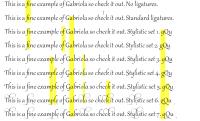 Word now fully supports Open Type, which means that ligatures and improved kerning are supported if these features are built in to the typeface. Ligatures are combinations of 2 or more letters into a single component (or glyph). One of the more common ligatures combines the characters "f" and "i". And kerning is the characteristic that allows letters to fit together properly on a typeset line.
Word now fully supports Open Type, which means that ligatures and improved kerning are supported if these features are built in to the typeface. Ligatures are combinations of 2 or more letters into a single component (or glyph). One of the more common ligatures combines the characters "f" and "i". And kerning is the characteristic that allows letters to fit together properly on a typeset line.
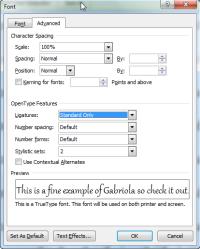 Up to 20 "stylistic sets" can be embedded in a given typeface. Gabriola is a typeface that's included with Office 2010 and with Windows 7. It includes good kerning tables, ligatures, and 7 stylistic sets.
Up to 20 "stylistic sets" can be embedded in a given typeface. Gabriola is a typeface that's included with Office 2010 and with Windows 7. It includes good kerning tables, ligatures, and 7 stylistic sets.
![]() These features are useful and, in the hands of someone who understands typography, they are welcome additions. But Word 2010 also makes hideous options available. With very little effort (or thought) it's possible to create a headlines with a gradient fill, a reflection effect, and an unearthly glow.
These features are useful and, in the hands of someone who understands typography, they are welcome additions. But Word 2010 also makes hideous options available. With very little effort (or thought) it's possible to create a headlines with a gradient fill, a reflection effect, and an unearthly glow.
 Bottom Line: The Best Word Processor Is Even Better.
Bottom Line: The Best Word Processor Is Even Better.
Although Word 2010 makes it easy to create truly terrible designs, the application earns 4 cats for its improved security, the ability to modify the Ribbon, and a wealth of other features. I haven't even mentioned the collaboration tools, which are quite impressive.
For more information, visit the Microsoft Word website. (Microsoft was still displaying Office 2007 as the current application at the time I wrote this review. This will soon change.)
In addition to my own review, I made use of information from Lynda.com's Word 2010 New Features program by Gini Courter, who has been teaching computer classes and seminars for more than 30 years at not-for-profit organizations, public and private companies, state and federal agencies, and educational institutions. She consults and trains in the Microsoft Office and SharePoint space, helping individuals and organizations use these tools to increase efficiency and work collaboratively. A founder and managing partner of TRIAD Consulting, Gini is also the author of 29 books, including Beginning SharePoint with Excel (Apress) and many titles in Sybex's popular Mastering series. Gini is a graduate of the University of Michigan with an MBA from Oakland University.
VueScan Should Have Come with Your Scanner
Several years ago, when I was doing considerably more scanning than I do today, I bought an Epson Perfection 3200 Photo scanner. Epson made drivers for Vista and even for Windows 7, but not for the 64-bit version of Windows 7. Although I don't use the scanner a lot these days, I do still need to use it from time to time, so I had a choice: Buy another scanner that's the equivalent of the Perfection 3200 (about $800) or install Ed Hamrick's VueScan (about $40).
Easy decision. The only problem is that I wish I'd bought VueScan several years ago. If you know nothing about scanners, the program will guide you. If you know a lot about scanners, you'll like the program's extensive control set. Either way, you win.
An Uphill Battle
VueScan is, in many ways an odd product; it's something that venture capitalists probably wouldn't want to bet on for one big reason: Every scanner comes with its own software. Why would somebody want to spent another $40 or $90 to buy third-party software? The answer is easy: VueScan works better than the software that came with your scanner, even if that software still works with your current hardware or operating system.
Hamrick says that he has always been interested in photography and, when he purchased an HP PhotoSmart film scanner in 1997, he was disappointed in the software that came with it. So he wrote his own program. Then he bought a Nikon LS-30, reworked his program (called VueSmart at the time) so that it would support multiple scanners and renamed it VueScan.
The Application for Every Scanner
You might be able to find a list somewhere of scanners that VueScan supports, but don't bother looking. It would be a very long list and the scanner you have probably is on the list. It would be easier to list the half dozen or so scanners on the planet that VueScan doesn't support. (That's a guess by the way. The number might not be that high.) According to the VueScan website, more than 1500 scanners are supported.
If your scanner is made by one of these companies, VueScan will probably run it: Acer/BenQ, Agfa, Apple, Avision, Braun Phototechnik, Brother, Canon, Dell, Epson, Fujitsu, Heidelberg, Hewlett-Packard, Kodak, LaCie, Lexmark, MediaX, Microtek, Minolta, Mitsubishi, Mustek, Nikon, OKI, Pacific Image Electronics, Plustek, Polaroid, Reflecta, Samsung, SmartDisk, UMAX, Visioneer, and Xerox.
When it comes to competitors, there's really only one and that's the very expensive SilverFast. SilverFast requires the manufacturer's driver so it won't work for me even though I own a copy of it for the Epson Perfection 3200 Photo scanner. If I buy another scanner, I would need to buy a new copy of SilverFast designed for that scanner. Or I could use the existing copy of VueScan.
 VueScan runs on Windows 95, 98, Me, NT, 2000, XP, Vista, and 7, both 32- and 64-bit, as well as on Linux and Mac OS X. Perhaps you're beginning to see the advantages.
VueScan runs on Windows 95, 98, Me, NT, 2000, XP, Vista, and 7, both 32- and 64-bit, as well as on Linux and Mac OS X. Perhaps you're beginning to see the advantages.
I bought the $40 standard version instead of the $80 professional version, but I may need to upgrade to the higher-priced pro program. The standard version doesn't allow the user to profile the scanner, something that's essential if you want to obtain the best possible scans.
Look Into My Interface
The interface is functional. Not pretty. If you turn all the advanced features on, it can be a bit overwhelming. But "functional" is a good thing to be. If you've used a scanner for any high-quality work, you'll probably understand the controls right away. If you haven't, then there are 2 options:
- Let the program guide you.
- Read the 91-page User Guide (provided as a PDF with the application download). In fact, even if you consider yourself a scanner virtuoso, it wouldn't hurt to read the User Guide.
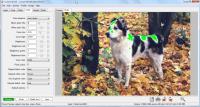 The dialog window is on the left side of the screen and the preview/scan window is on the right side. You'll see status information at the bottom. To use the program's advanced features, you'll deal with a total of 6 tabs: Input, Crop, Filter, Color, Output and Prefs. By default, the basic interface is displayed and each pane has an Advanced button that reveals all the neat stuff.
The dialog window is on the left side of the screen and the preview/scan window is on the right side. You'll see status information at the bottom. To use the program's advanced features, you'll deal with a total of 6 tabs: Input, Crop, Filter, Color, Output and Prefs. By default, the basic interface is displayed and each pane has an Advanced button that reveals all the neat stuff.
Although VueScan offers some options for image correction, I recommend that you tread lightly here. Get the basic scan right, but don't spend a lot of time trying to fix colors and the like during the scan process. Save a large, high-resolution TIFF image (or, if you buy the professional version, a camera raw image) and then do all of the restoration and modification in Photoshop.
 Bottom Line: If You Have a Scanner, You Need VueScan.
Bottom Line: If You Have a Scanner, You Need VueScan.
In a perfect world, every scanner manufacturer would stop trying to create a good scanner application and would just bundle Ed Hamrick's VueScan with their hardware. Since they don't, it's up to you to put the bundled software on a shelf with other useless junk and to buy VueScan. Because the $90 pro version includes all future upgrades, you'll never have to buy it again.
For more information, visit the VueScan website.
My "Itunes" "Purchase"
There it was, amidst the offers for "generic" Viagra, a message from Itunes thanking me for purchasing a gift certificate. That's something I have done, but not recently, so I knew it was a fake. I thought I'd take a look, though, because the fakes that try to plant malware on your computer continue to get better.
 The message showed up in my SpamArrest list of messages from sources that haven't been verified. Had the message really come from Itunes, it wouldn't have been there. The real Itunes address is on my verified list, so the message would have come directly to me without passing through this area.
The message showed up in my SpamArrest list of messages from sources that haven't been verified. Had the message really come from Itunes, it wouldn't have been there. The real Itunes address is on my verified list, so the message would have come directly to me without passing through this area.
 Here I've opened the message in SpamArrest. Two dead giveaways exist that this isn't a message I want to believe: First, the recipient is listed as "borekci@spamarrest.com" (not my address) and the message contains a compressed (zip) file (not how Itunes sends gift certificates). By sending a zip file, the bad guys can avoid some anti-fraud measures that can't see inside compressed files.
Here I've opened the message in SpamArrest. Two dead giveaways exist that this isn't a message I want to believe: First, the recipient is listed as "borekci@spamarrest.com" (not my address) and the message contains a compressed (zip) file (not how Itunes sends gift certificates). By sending a zip file, the bad guys can avoid some anti-fraud measures that can't see inside compressed files.
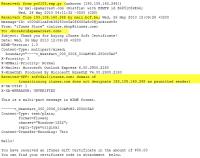 Then I looked at the message source and found even more reasons to delete the message without opening it:
Then I looked at the message source and found even more reasons to delete the message without opening it:
- The message originated in Greece. The last time I checked, Itunes was part of Apple, which is located in Cupertino, California.
- The message was passed through a server in Belgium on its way to the United States (see above).
- As noted previously, the recipient of the message is "borekci@spamarrest.com". This is not me and nobody uses their SpamArrest address to receive legitimate messages.
- The message failed the SPF (Sender Policy Framework) test because Itunes doesn't send messages from IP address 193.108.160.248, which is assigned to the Hellenic Open University in Greece.
The fakes continue to get better, so that means that we need to get smarter. Before you click, it's even more important to THINK!
Short Circuits
Are You Serious?
This week I was talking with a company that provides a service to some fairly large businesses. I needed to send my contact some information, so I asked for his e-mail address. "NotSeriousAboutBusiness@aol.com" he said. Well, he didn't really say "NotSeriousAboutBusiness", but he might as well have.
If you expect people to take you and your business seriously, to believe that you're really in business, you won't use an AOL address, a Yahoo address, a Hotmail address, or a Gmail address. All of these are fine for personal addresses, but not for business addresses. Actually, I don't consider them to be very good personal addresses either.
Why You Need a Business E-mail Address
You don't use your home phone number for the business, do you, even if the business is located in your home? You have a website, don't you? You may even have a fax number; at one time, having a fax number was essential, but that's no longer the case. And you probably have business cards, letterhead, and all the other things that businesses are expected to have. Why continue to use an e-mail address that says so many negative things about your business?
For most people, it's not the cost of having a good e-mail address; it's just inertia and resistance to change. For about $40 per year, you can register a domain name and have all the e-mail addresses you could ever want.
When I write to computer industry contacts, my messages come from "techbyter.com". When I write to clients, my messages come from "blinn.com". Registering a domain costs, in most cases, $10 to $15 per year. If you don't need a website, you can add e-mail addresses for just a few dollars. And if you already have a website, your service provider probably includes e-mail addresses without additional charge.
So if you're serious about your business, make sure that you have an address that supports your claim.
Vacationing with Co-Workers
I've been on vacation this week with a co-worker and her husband. Not exactly in the car with them as they travel through the West, but watching closely. Every night they post the day's pictures on their website. How we use photography has changed so much in the past 20 years or so!
Remember Fotomat? You could find their drive-through kiosks in shopping center parking lots. For a while the company was listed on the New York Stock Exchange and, at one time, there were more than 4,000 Fotomats throughout the United States. That was in the 1980s. Then came digital photography.
The company offered one-day photo development, which became obsolete as drugstores and others installed one-hour photo development system. Fotomat eventually became an online service for digital photographers, but discontinued that operation in 2009.
And what about Kodak? Kodak was THE film company. In the past 15 to 20 years, it has tried to position itself as the picture company, but this has been largely unsuccessful. Few people have prints made these days because they can share photos online or via e-mail.
For somebody like me who spent a lot of years producing images on film, this has been a bit of a shock. But the ability to create an image, modify it on the computer, and share it immediately with people worldwide certainly has its advantages.
Incidentally, Friday was a vacation day and I spent some time at the zoo. After several decades, the zoo again has polar bears. Last year's baby elephant is now a toddler. And several lion cubs were playing the way kittens play. Yes, I do have pictures.
Reclining with Your Ipad
Regardless of how "cool" it is, I don't own an Ipad and I don't plan to own one anytime in the near future. But a lot of people do and the market for add-on hardware is hot at the moment. I've seen keyboards, stands, and other accessories designed for the Ipad. One that looks interesting is the Recliner by LapWorks.
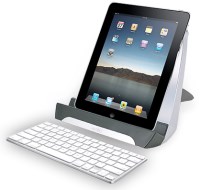 I've previously described other products developed by LapWorks, including the company's devices that turn a notebook computer into a device that can actually be used on your lap without setting your clothes on fire.
I've previously described other products developed by LapWorks, including the company's devices that turn a notebook computer into a device that can actually be used on your lap without setting your clothes on fire.
The LapWorks Ipad Recliner can be thought of an as "easy chair" for an Ipad. It improves the viewing angle and can also elevate the Ipad so that the screen is easier to see.
The image shown here displays the recliner with an Ipad and an optional keyboard.
LapWorks is more than 10 years old and has been providing laptop users with devices that make portable computing easier and and more ergonomic. For more information, visit the LapWorks website.
Remember When We Thought Apple Would Fail?
I was one of those people who, during the darkest days of the company's history, thought that Apple would go out of business. Then came OS X, the Ipod, and Itunes. This week, something remarkable happened: Apple's value exceeded that of Microsoft.
Based on the value of the companies' stock, Apple became the world's most valuable tech company on Wednesday. Apple's market capitalization ended the day $222 billion ($244.11 per share) and Microsoft's market capitalization was $219 billion ($25.01 per share).
In January, Microsoft's value exceeded Apple's by $80 billion. In Redmond, this can't be seen as a good trend.


 The author's image: It's that photo over at the right. This explains why TechByter Worldwide was never on television, doesn't it?
The author's image: It's that photo over at the right. This explains why TechByter Worldwide was never on television, doesn't it?
